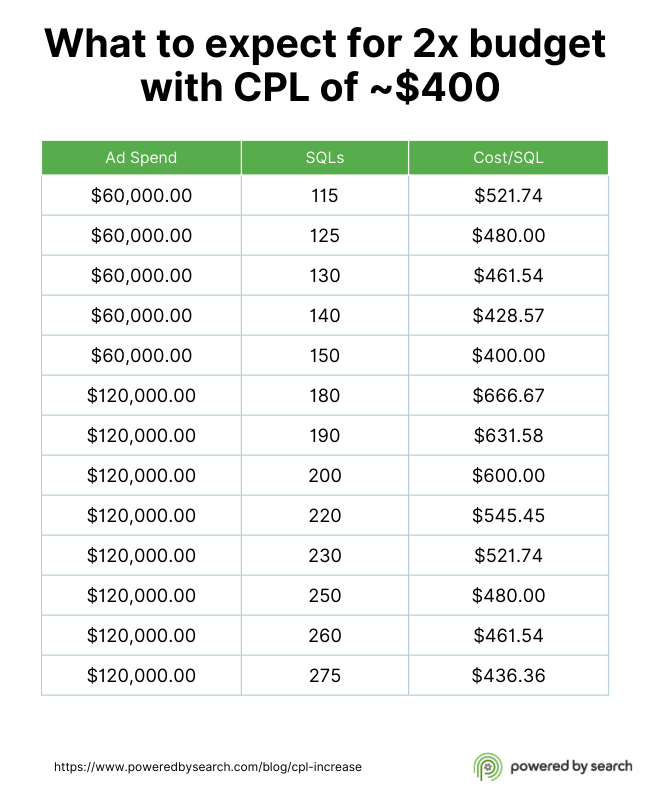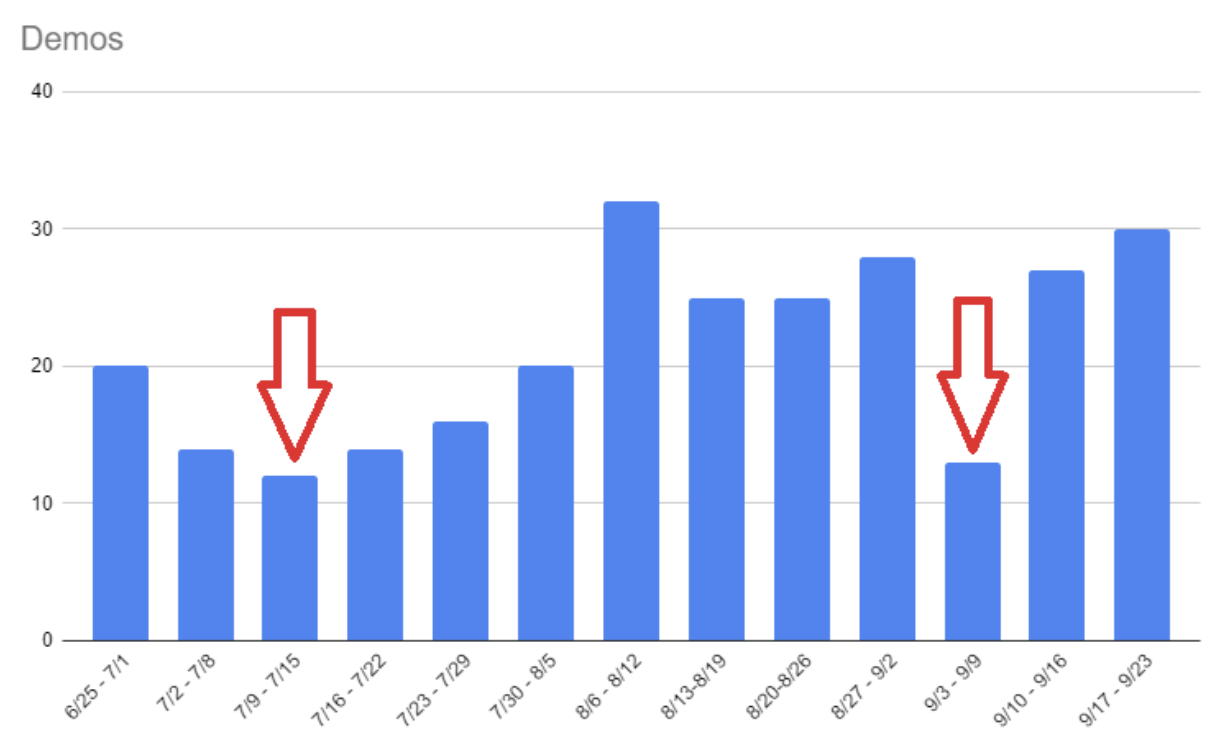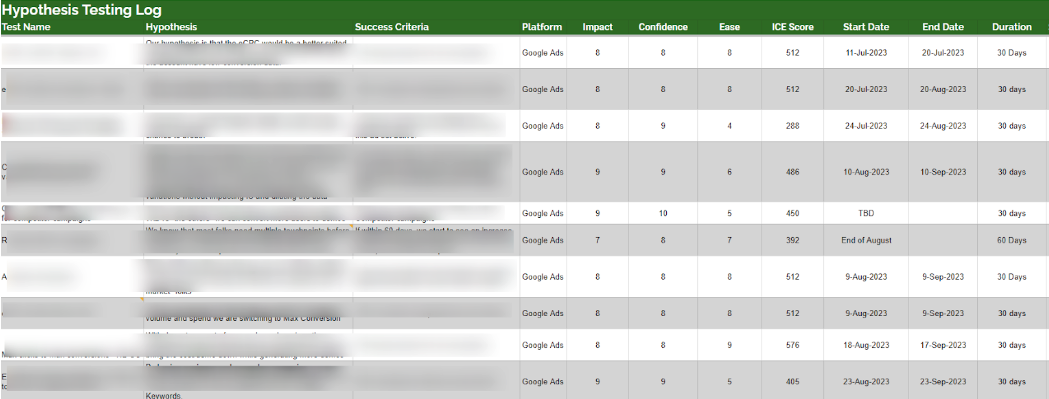Why cost per lead increases (and how to decrease your CPL)
Last updated: November 23rd, 2023
If your budget was slashed but you still need to hit numbers, reducing your cost per lead is an obvious solution, though it’s easier said than done.
Many B2B SaaS marketers feel pressure from executives to take massive action to achieve quarterly and annual goals, though making major changes to your paid campaigns can actually cause your CPL to increase.
This is because most advertising platforms need time to figure out who to show your campaigns to and they can’t gather sufficient data if you’re constantly making changes.
Nevertheless, the good news is that you can still significantly decrease your CPL without making drastic changes to your campaigns.
In this post, we’ll first discuss the factors that cause CPLs to increase, how they impact customer acquisition, and the exact strategy we use to lower CPLs for a short period of time.
Need help reducing your cost per lead? Get your Free Marketing Plan here to find out how we can help you optimize your campaigns.
Why is cost per lead important?
When you want to measure the cost-effectiveness of a B2B SaaS PPC campaign, you can’t go wrong by paying attention to your CPL.
It tells you how much a lead currently costs, allowing you to make projections and set targets to get more out of your campaigns.
It’s an easy metric to calculate:
Total campaign spend / Total new leads = cost per lead
For example, if you spent $80,000 on a campaign and acquired 400 SQLs, your CPL is $200.
The lower the CPL, the better value you’re getting from your campaigns. The quality of the leads needs to be considered too, of course, but CPL is still a powerful indicator when making decisions.
For example, if you see that your CPL is creeping up, it’s clear that your campaign is losing its effectiveness, and needs some attention. If it gets too high it will cost more than the leads are worth, making it an inefficient spend of your marketing budget if conversion is the goal.
This is why SaaS companies are forever trying to lower their CPL, but it’s not quite as simple as they often assume.
There’s no linear relationship between CPL and investment
Most B2B SaaS companies take a very linear and simplistic approach to their CPL.
They set a target CPL, then once they reach that target, they try to simply throw more money into the campaign.
The expectation is that by spending more money, the number of leads will grow in parallel to the increased investment, while the CPL will remain the same. Some companies even expect the CPL to go down when they invest more money. But, in actuality, the CPL is more likely to go up than stay the same, and it certainly won’t go down.

It’s like if you were fishing in a pond: You’ve found the perfect spot, and you’re catching lots of fish, but you want to catch more.
To double your catch, you decide to add a second identical fishing line.
Will you double your catch? Probably not.
There may not be enough fish in that section of the pond, or the rest of the fish that are there may not be drawn to that type of lure. Or even worse, the second line is too much — it scares the fish away, and you end up catching fewer fish than when you started!
Instead, you should be trying different lures, positioning the second line in a different part of the pond, or fishing in a different pond altogether.
And because you’re not here to learn about fly fishing, let’s bring this back to your PPC campaigns.
You can’t just do more of the same thing and expect an exponential increase. You need to try new things to see what works for your target audience.
Your acquisition model needs to reflect this approach too, as your projected growth will likely be inaccurate if you’ve based them off unrealistic targets.
What Causes Your CPL To Increase?
Plenty of external factors can cause CPLs to increase, such as reduced targeting accuracy due to privacy regulations and a general increase in competition across all paid media.
However, plenty of SaaS marketers unintentionally increase their CPL because they make too many changes at once. If you make big changes, the algorithms go through a period of turbulence while they re-learn what works best based on your new campaigns, which can throw off the prior learnings that got you the right results in the first place.
For example, you might change the keywords, ads, and bidding strategies simultaneously because you believe each variable could be improved.
While that assumption may be true, changing all of them at once will likely increase your CPL because the algorithms will have to start testing again from scratch rather than iterating based on their current strategy.
For example, you can see in the graph below that demos dramatically dropped when a client requested we make many changes at once to their ad strategy:

We realize that if you’re facing budget cuts, you can’t afford to sit and wait to see what works. However, you’ll throw money away if you continuously change the ad campaigns and strategies before the algorithms can find the right audience.
The good news is that making small optimizations based on the right data can help you reduce your CPL in a timely manner.
Next, we’ll show you the step by step process we use to consistently decrease CPLs for SaaS companies.
In fact, we’ve followed this process to help a data governance SaaS reduce their CPL (MQLs in this case) from $1,200 to $300 just three quarters into our partnership. Today, their MQLs are four times cheaper than when we started!
How to decrease your cost per lead
If decreasing your CPL is about making small changes, what are the changes you should make, how much time should you give them, and how do you use the new data to continue optimizations?
Below we’ll outline the simple process we use to help clients efficiently reduce CPLs without causing an immediate spike that eats up the marketing budget.
1. Identify What’s Currently Working/Not Working
Before making any changes, do an audit of your current strategy and identify the marketing campaigns that are currently driving the 80/20 of your results and cut the lowest performing channels/campaigns.
If you’re operating with a reduced budget, this is particularly beneficial because it allows you to refocus that budget to the highest ROI campaigns rather than spreading it thinly across a variety of campaigns.
To identify what’s working and what isn’t working well, make a list of all the campaigns that you’re running and the variables within each campaign (keywords, ad creatives, etc.), and then order the campaigns by highest to lowest performing. Be sure to order this list by CPL costs rather than just cost per clicks as clicks that cost more might convert at a higher rate and ultimately result in lower CPLs.
Once you’ve identified the highest performing campaigns and cut the lowest performers, assign an ICE (Impact, Confidence, Effort) score to each variable you want to change based on highest impact and lowest effort.
We also keep hypothesis logs that show what we’ve tested in the past so that we can use data to guide new changes and avoid making the same mistake twice.

2. Test and Optimize
If you’re trying to make drastic improvements, you’ll probably be tempted to make multiple changes at once. Yet if you make multiple changes at once, it becomes impossible to accurately determine which change had which effect on the CPL, and without that data, you can’t make informed decisions later on.
Instead, we identify the lowest hanging fruit and implement just one change at a time.
The changes you can make vary from industry to industry, so choose the change you believe will have the greatest impact. Having said that, there’s minimal risk if you make the wrong decision, so don’t spend too much time or energy trying to pick the perfect change.
The most effective way to implement these changes is by setting up A/B tests that allow you to directly compare the new copy with the original copy.
Once you’ve made your change or set up a test, keep an eye on the results and monitor any changes to the CPL to get the most out of the next step.
Here’s what that looks like in our hypothesis logs. We track the success (or failure) of these tests so we capture the learnings no matter the outcome. You can use similar columns to the screenshot above (we blurred out the details of our clients’ tests).

This ensures we don’t waste budget retesting elements that previously performed poorly and it provides solid data to test new variations.
New ad copy & creative
Over time, buyers get used to your ad creative. In order to stop them becoming fatigued by your messaging, you should update your ad copy & creative regularly.
Two issues we frequently encounter when auditing accounts is that marketers either:
- Aren’t testing their ad copy at all, or
- They’re testing redundant headlines (e.g., “best software for X” vs “#1 software for X”).
Instead, test different variations that are significantly different and even appeal to different buyer psychologies (e.g., logical, emotional, etc.).
Testing different ad copy & creative is not only an affordable way to improve the effectiveness of a campaign, but it’s also one of the most effective.
Another issue we frequently encounter with incoming ad accounts is that the marketing team accidentally sets the ad copy rotation to evenly rotate rather than setting the ad platform to rotate the top performing ad copy.
Unfortunately, providing equal budget to both underperforming and top performing ads is a sure way to increase your CPL, as the top performing ad can clearly drive a higher ROI.
New keyword combinations
Trying new keyword combinations and variations can significantly reduce your CPL if you find just the right combination, but you can also waste a lot of money testing and searching for the right keyword combinations.
Selecting new keyword combinations based on assumptions and guesswork isn’t the most efficient method to find a winner. Instead, use data based on past conversions to identify and test new keywords.
Specifically, we often check the search query reports and identify the specific keywords that triggered the conversion – not just the target keyword that triggered the conversion.
For example, the campaign that triggered the conversion may be targeting the keyword “vulnerability management software,” yet the actual search query that the user typed in before seeing your ad and converting may have been “best vulnerability scanner.”
Therefore, we might create a campaign targeting “best vulnerability scanner.” By using data to find keywords that have already proven to convert, we’re much more likely to find a winning keyword combination faster. This means each test is more likely to succeed, which helps you reduce your CPL faster.
Another consideration when selecting keywords is to avoid looking exclusively at cost per click metrics. Often, a keyword may have a higher cost per click, but ultimately have a lower cost per lead metric if it converts at a higher percentage.
New locations
When your budget is slashed, the geographic regions that you previously exhausted may have more potential to drive a better ROI and therefore reduce your CPL.
This is because, previously, when you had a larger budget, you were able to reach everyone in that region with your ads. However, now that you have a reduced budget that’s still spread across all of the same regions, your ads will likely only be shown to a smaller percentage of the population in that region.
So a great way to reduce your CPL after a budget cut is to eliminate the underperforming regions from your location targeting and concentrate your budget on the locations that have proven to produce the best CPLs.
Another tip to further reduce your CPL is to refine your targeting by excluding regions that don’t convert well. For example, if you’re spending a lot of money in South Dakota, but you’ve never received a conversion from that region, eliminate it from your location targeting.
It’s not uncommon that when we start working with a new account, they’re targeting all 50 states, and we’ll refine location targeting to only, say, 26 states.
New campaign
If you wanted to take a slightly more radical approach, you could create a whole new campaign with the extra budget.
There’s more risk involved with this approach given that new campaigns can take around 2-4 weeks to stabilize, but it can work if your current campaigns are performing very poorly and/or you have new data or targets.
This strategy may require more iterations and tweaks early on, but once you get results, you can continue improving it with the changes we’ve already discussed.
3. Review the CPL
Reducing your CPL is an iterative process, so you must regularly review the CPL of your changes to measure the effectiveness of your tests. You shouldn’t expect the CPL to drop immediately, but you should watch for the effect of changes you make.
If it looks like the change is driving the CPL up and it doesn’t look like it’s coming back down, go back to the test and optimize stage to identify what was working and iterate based on that data.
By taking this approach, you make adjustments in small steps, rather than big sweeping changes, so that you don’t have a big spike in your CPL as you work to bring it down.
The only big jumps you should expect to see in your CPL is when you increase the budget, as shown in the diagram below where we’ve plotted ad spend by month versus CPL (cost per SQL)

This is to be expected, and through testing and optimizing your approach, you’ll gradually bring that back down and keep it within a manageable range.
For example, we worked with a cybersecurity SaaS company that requested many changes to their ad strategy simultaneously.
Even though their CPL was healthy, we typically had to walk back some of the changes to understand which ones were effective. However, once we let the changes ride for a week or two, results started to improve and CPL dropped almost in half.
Take Action to Reduce Your CPL Today
You may be tempted to make drastic changes to reduce your CPL as stakeholders and executives pressure the marketing team to drive more leads with a reduced budget.
However, making major changes will create the opposite effect and actually increase your CPL.
Instead, use the tips above to gradually reduce your CPL. Even though making small incremental changes may seem like a poor strategy when you have numbers to hit by looming deadlines, this strategy will actually help you hit your goals faster.
You can experiment with the tips in this post, yet there is a lot of nuance to each step. So if you’d rather bypass the expensive (and rather frustrating) experimentation phase and instead work with a team of professionals that has executed this process for plenty of teams in the past, consider reaching out to us at Powered By Search.
Reach out and we’ll give you a free marketing plan to identify the lowest hanging fruit to reduce your CPL and help you hit your targets despite a reduced marketing budget.
What you should do now
Whenever you’re ready…here are 4 ways we can help you grow your B2B software or technology business:
- Claim your Free Marketing Plan. If you’d like to work with us to turn your website into your best demo and trial acquisition platform, claim your FREE Marketing Plan. One of our growth experts will understand your current demand generation situation, and then suggest practical digital marketing strategies to hit your pipeline targets with certainty and predictability.
- If you’d like to learn the exact demand strategies we use for free, go to our blog or visit our resources section, where you can download guides, calculators, and templates we use for our most successful clients.
- If you’d like to work with other experts on our team or learn why we have off the charts team member satisfaction score, then see our Careers page.
- If you know another marketer who’d enjoy reading this page, share it with them via email, Linkedin, Twitter, or Facebook.